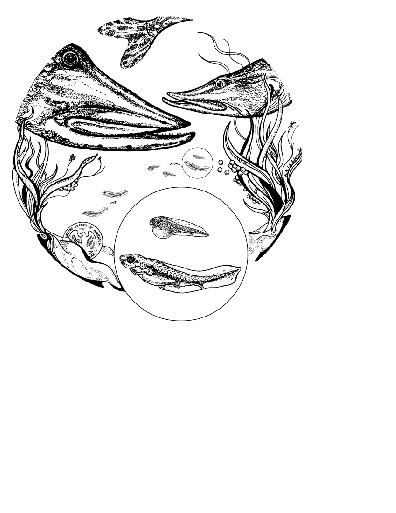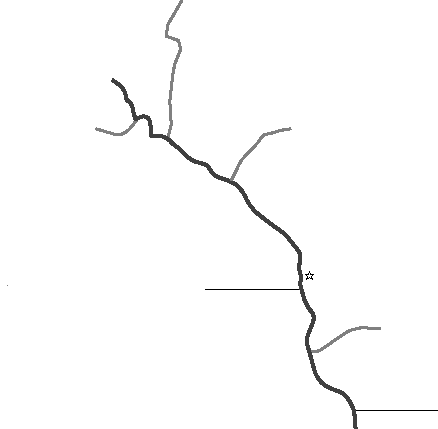Mississippi River
Note 2- Genoa National Fish
Hatchery and Freshwater Mussels
|
|
There are lots of places in
the Upper Mississippi where fish
can breed and grow, but the Genoa
National Fish Hatchery, south of
Genoa, Wisconsin, offers a
controlled environment for fish
research and production. This
200-plus-acre federal facility
raises everything from bluegills
in ponds to Great Lake sturgeons
in indoor tanks. In 1995, Genoa
became the first federal hatchery
where researchers attempted
moving native mussels out of
zebra mussel-infested waters.
The hatchery, which is
bisected by Highway 35, is a
series of ponds laid out along
the final mile of the Bad Axe
River before it empties into the
Mississippi. It was established
in 1932, on former farmland, and
began producing fingerling bass
and bluegills in 1934. The
hatchery provides eggs and fry
(young fish) free to state and
federal stocking projects.
|
|
Collecting Eggs
Genoa is one of only
three federal facilities
that collects eggs from
wild walleye and sauger.
Early each spring,
hatchery workers gather
eggs and milt (sperm)
from fish that spend
their entire lives in
the river. After netting
a fish, workers stun it
with a small electric
shock. Walleye eggs and
milt can be stripped
(gently squeezed out) on
the boat, then someone
from the Wisconsin
Department of Natural
Resources (DNR) weighs
and records data before
adult fish are returned
to the river.
|

|
|
|
Northern pike, sometimes
called "slimers," are harder to
handle because of a thick layer
of slime on their skin, a mouth
full of sharp teeth and an
aggressive nature. Northerns are
held at the hatchery for an
average of three to four days,
until the time is right to gather
their eggs and milt. They are
then returned to the river.
Specially designed jars hold
the fertilized eggs while flowing
wellwater keeps the eggs loose
and free of algae. After 11 to 21
days, the fry hatch and wash into
long tanks where they absorb
their yolk sacs. Then they're
moved to ponds until they're
one-and-a-half to six inches
long. Ten percent of the hatched
fish are returned to the area
where the eggs were collected.
Most of the walleyes hatched
at Genoa are used to stock tribal
waters, although occasionally
some go to wildlife refuges.
Northern pike fry and eggs
usually go to states for stocking
areas disturbed by Army Corps of
Engineers projects.
|
|
Protecting
Threatened Fish
|
|
The Genoa hatchery
has evolved from simply
raising sport fish to
protecting threatened
fish and helping with
environmental management
projects. Managers at
Horicon Refuge in
central Wisconsin hope
northern pikes from
Genoa will stop a
growing carp population.
Fisheries managers
use the hatchery to
maintain brood stocks of
fish threatened by
disease and pollution.
Fish are held in
isolation for about two
years and inspected for
disease three times,
before the hatchery can
ship their eggs and
fry.Since 1996, Genoa
has preserved brood
stocks of lake trout and
coastal brook trout.
These fish are native to
the Great Lakes, where
disease makes it
impossible to safely
gather uncontaminated
eggs.
The hatchery has
raised about 6,000 lake
sturgeons each year
since 1994. Sturgeons
will not eat pelleted
food like most other
hatchery fish. When
first hatched in indoor
tanks, sturgeons eat
small brine shrimp
hatched in the same
tanks.When the sturgeons
get bigger they're fed
zooplankton seined from
the hatchery's ponds.
Eventually, they eat
adult brine shrimp from
another facility.
Genoa is helping to
reintroduce sturgeons to
the Wolf River. Two dams
built near Shawano,
Wisconsin, in the early
1900s cut off the
sturgeons from the
headwaters, effectively
eliminating them in the
area that is now the
Menominee Reservation.
|
|
Protecting
Native Mussels
|

|
|
|
In 1995, the Genoa
hatchery began research
to help save the Upper
Mississippi's native
mussels from being
destroyed by invasive
zebra mussels.
Zebra mussels, native
to Europe, probably
arrived in the Great
Lakes in the ballast
water of trans-Atlantic
ships. The zebras spread
to the Mississippi
through the
human-created canals and
rivers that connect the
river with Lake
Michigan.Zebra mussels
cripple native mussels
by attaching to their
shells, and compete for
food and oxygen.
Researchers from the
Upper Mississippi
Resource Conservation
Committee (UMRCC)
collected several
species of native
mussels from an infested
spot in the river,
scrubbed them clean of
visible zebras, then
quarantined them for 35
days.Mussels were placed
in four kinds of
structures, or
treatments, and returned
to the river (the
control set) or put into
a quarter-acre pond at
the hatchery.
The first test
treatment, called
"shoe-bag" structures,
are nylon mesh bags with
an individual pocket for
each mussel. They were
placed upright about an
inch above the bottom.
The second and third
treatments used metal
trays filled with dredge
material. The mussels
were placed inside, and
the trays were either
buried or suspended a
few feet above the
bottom. The final
treatment used a metal
barrier, or corral, on
the bottom to prevent
the mussels from
wandering away.
The experiment had
four goals: (1) develop
a method to move healthy
native mussels without
transporting zebra
mussels; (2) compare
growth and survival of
mussels in artificial
ponds and in the river;
(3) determine whether
some species survive and
grow better after
moving; and (4) decide
which treatment gives
the best survival and
growth rates.
Results suggest that
mussels such as the
mapleleaf (Quadrula
quadrula), pigtoe
(Fusconaia flava) and
threeridge (Amblema
plicata) can be moved
with some success.
Others, such as the
fragile papershell
(Leptodea fragilis) and
threehorned wartyback
(Obliquaria reflexa),
cannot. Of the four
treatments, mussels in
the suspended trays
seemed to grow
best.Finally, the pond
environment at the
hatchery appears less
productive than the
river. Future research
will study how best to
feed mussels in
artificial environments.
While the project did
not create an ideal home
for native mussels, it
succeeded in several
ways."We showed that it
is possible to move
natives without
transplanting zebras,"
says Kurt Welke,
fisheries biologist for
the Wisconsin DNR. "And
we developed a set of
protocols -- or handling
procedures -- that will
make it possible for us
to move mussels in the
event that somebody
decides we need to in
order to save them."
Projects at other
national hatcheries,
which began after the
Genoa project broke the
ice, have pushed the
research further, and
have even hatched new
mussels in artificial
environments.
|
|
|
|
Things to Do & See
|
|
Tours
The Genoa National Fish
Hatchery does not currently have
a visitor's center, but can
accommodate group tours arranged
in advance. For information
contact Todd Turner, hatchery
manager, at (608) 689-2605.
|
River Aquarium
You can see some native fish
and a display of native mussel
shells at the Iowa State Aquarium
located in Guttenberg, Iowa. The
Aquarium is usually open for
visitors from May to October.
Call (319) 252-1156 to check the
hours.
|
Fisheries Schools
According to Todd Turner, the
University of Wisconsin-Stevens
Point offers one of the finest
schools for fisheries biology.
Bemidji (Minn.) State University
and the University of
Arkansas-Pine Bluff also offer
fisheries programs.
|
|
|
|

|
|

The illustration at left shows five stages of
northern pike development: eggs clinging to the underside of
vegetation; newly hatched fry retaining yolk sacs; older
larvae that have nearly used up their yolk supply; an
immature pike; and an adult.
Northern pike eggs are about 3.4 mm long,
slightly more than one eighth the diameter of a quarter
(diagrammed in the lower left corner). The remaining stages
of pike are also shown to scale.
Illustration by Mi Ae Lipe-Butterbrodt.
For Your Information
An excellent handout describing the life cycle of
mussels is available from the James Ford Bell Museum of
Natural History at the University of Minnesota. Write to the
James Ford Bell Museum, 10 Church Street SE, Minneapolis, MN
55455.
While not specific to the Upper Mississippi, the
Virginia Polytechnic Institute and State University offers a
poster of America's Pearly Mussels. You can order a copy for
$5.00, plus $2.50 shipping and handling from Extension
Distribution Center, 112 Landsdowne Street, Blacksburg, VA
24061-0512. Checks should be made out to "Treasurer,
Virginia Tech."
Todd Turner, manager of the Genoa Fish Hatchery,
provided information about hatchery history and practices.
Kurt Welke, biologist for the Wisconsin DNR in
Prairie du Chien, Wis., and Rhonda Kenyon, of the La Crosse,
Wis., office of the DNR provided information about the
mussel relocation project.
This and other River Notes are available on the
Big River World Wide Web site (www.big-river.com) or from
the Minnesota-Wisconsin Boundary Area Commission, 619 Second
St., Hudson, WI 54016-1576; (612) 436-7131 or (715)
386-9444.
Mississippi River Notes are created by Riverwise,
Inc. (P.O. Box 204, Winona, MN 55987) for the
Minnesota-Wisconsin Boundary Area Commission, with support
from the McKnight Foundation.
This River Note is in the public domain. You may
copy and distribute it without permission.
January 1998
|
